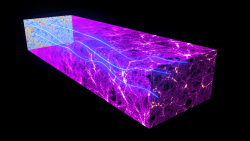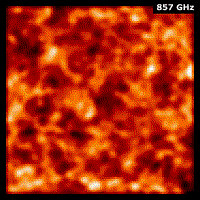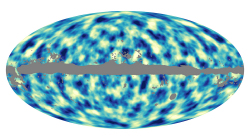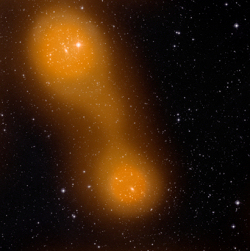Planck's exploration of the origin and growth of cosmic structure
Beyond its main goal – imaging the Cosmic Microwave Background (CMB) in unprecedented detail – ESA's Planck satellite has also probed the build-up of structure in the Universe in several different ways.
 |
| Gravitational lensing of the Cosmic Microwave Background. Credit: ESA/Planck Collaboration |
Since the CMB is the most ancient light that has travelled across the Universe, its photons have encountered and interacted with a multitude of structures that were taking shape during their almost 14-billion year journey. Stars and galaxies started to form a few hundred million years after the Big Bang and, over time, increasingly large objects were assembled, with galaxy clusters arising in the densest knots of the cosmic web that permeates the Universe.
One of the interactions between CMB photons and cosmic structure, leaving a lasting mark on the CMB, is gravitational lensing, the bending of light caused by massive objects. The dark matter halos in which galaxies and galaxy clusters are embedded act as lenses and deflect the path of photons. Analogous to what happens when light rays pass through a glass lens, the effect of gravity on the photons causes distortion to the image of distant sources.
The CMB photons are deflected multiple times as they cross the large-scale distribution of cosmic structure, resulting in tiny distortions to the already mottled pattern of the CMB temperature fluctuations. This gravitational lensing effect on the CMB, discovered with previous experiments on small patches of the sky, was mapped over the entire sky for the first time using data from Planck. Cosmologists have used this measurement to reconstruct an all-sky map of the gravitational potential that distorts the CMB, studying in ever greater detail the evolution of structure formation in the Universe.
Another type of interaction also takes place when the CMB photons encounter individual structures – galaxy clusters - in the large-scale distribution of cosmic matter. Galaxy clusters are the largest objects in the Universe that are bound by gravity: besides galaxies, they contain large amounts of ionised gas and even larger amounts of dark matter.
When photons from the CMB scatter off free electrons in the gas that permeates galaxy clusters, their energy is changed in a distinctive way. This is known as the Sunyaev-Zel'dovich effect and allows scientists to identify galaxy clusters from observations of the CMB. Planck has found over a thousand galaxy clusters across the entire sky, including almost 400 brand new detections. Among these are also several superclusters and the first observation of inter-cluster gas bridging two clusters.
 |
| Cosmic Infrared Background fluctuations observed by Planck at various frequencies. Credit: ESA/Planck Collaboration |
With its broad spectral coverage, Planck is also sensitive to another type of background radiation that peaks at shorter wavelengths than the CMB, the Cosmic Infrared Background (CIB). In contrast to the CMB, which is the diffuse light from the early Universe, the CIB is a cumulative background with contributions from all of the star-forming galaxies across cosmic history.
Observations of fluctuations in the CIB performed with Planck at different wavelengths have been used to trace the large-scale distribution of star-forming galaxies at different epochs in cosmic history. Besides the CIB, which is a cumulative radiation, Planck also detected the brightest galaxies as individual, discrete sources. Once removed and catalogued, what had been considered a foreground nuisance for cosmologists has turned into a valuable resource for studying the formation and evolution of galaxies – in particular dusty, star-forming galaxies and those hosting an active galactic nucleus.






